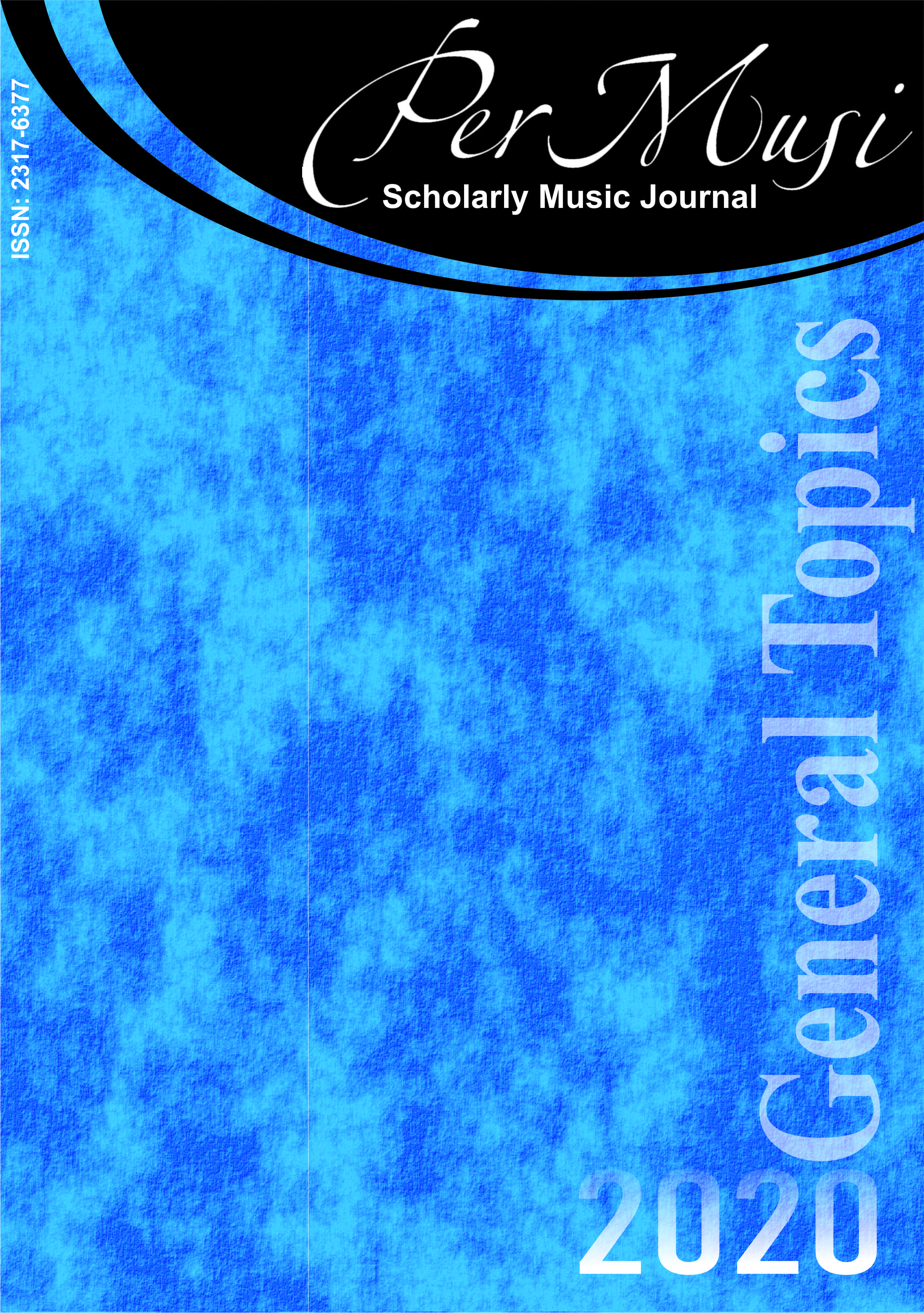Quarteto de Cordas nº 3 de Alfred Schnittke
uma análise de suas intertextualidades
DOI:
https://doi.org/10.35699/2317-6377.2020.20068Palavras-chave:
Alfred Schnittke, Intertextualidade, Processo composicional, Análise musicalResumo
Este estudo é uma análise do processo composicional intertextual de Alfred Schnittke no seu Quarteto de Cordas nº 3 (1983). O objetivo da análise é compreender como Schnittke abstrai elementos musicais de obras de outros compositores (“textos”) para reutilizá-los em seu Quarteto, especificamente o tema da Grande Fuga op. 133 de Beethoven, um motivo do Stabat Mater de Orlando Di Lasso e o monograma DSCH de Dmitri Shostakovich. Para tanto, este estudo discorre sobre: o uso de citações e alusões segundo Schnittke; a gênese e a estrutura do Quarteto de cordas nº 3; e a forma como os textos apropriados por Schnittke são resignificados em sua obra. A análise demonstrou que Schnittke realiza diversas transformações nos textos abstraídos para adaptá-los ao contexto sonoro e estrutural do Quarteto de cordas nº 3.
Referências
Albrechtsberger, Johann Georg. 1790. Gründliche Anweisung zur Composition. Counterpoint studies with Albrechtsberger. Leipzig. Disponível em: <http://www.beethoven-hausbonn. de/sixcms/detail.php?template=portal_en>. Acesso em: 10/01/2017.
Andreica, Oana. 2012. “Alfred Schnittke’s Polystylistic Journey: The Third Quartet”. Studia UBB Musica, LVII, 1: 103-115.
Bicknell, Jeanette. 2001. “The Problem of Reference in Musical Quotation: A Phenomenological Approach”. Spring. The Journal of Aesthetics and Art Criticism 59 (2): 185-191.
Bloom, Harold. (1973) 2002. A Angústia da Influência: Uma Teoria da Poesia. 2ª. ed. trad. Marcos Santarrita. Rio de Janeiro, Imago.
Bueno, Marco Aurélio Scarpinella. 2007. Schnittke: música para todos os tempos. São Paulo, Algol.
Cervo, Dimitri. 2015. “Influência, intertextualidade e pós-modernismo: Cervo x Schnittke um estudo comparativo”. Música em Perspectiva: 9-48.
Grew, Sydney. 1931a. “Beethoven’s ‘Grosse Fuge’”. The Musical Quarterly, Vol. 17, No. 4: 497-508.
Grew, Sydney. 1931b. “The 'Grosse Fuge': An Analysis”. Music & Letters, Vol. 12, No. 3: 253-26.
Griffiths, Paul. 2012. Disponível em: <http://www.shostakovichquartets.com/quartets/page/quartetno-8>. Acesso em: 16/01/2017.
Hatten, Robert. (1985) 1994. “El puesto de la intertextualidad en los estudios musicales”. Traduzido de: “The Place of Intertextuality in Music Studies”. American Journal of Semiotics, vol. 3, n. 4: 69-83. Criterios, La Habana, n° 32: 211-219.
Hatten, Robert. 1994. Musical Meaning in Beethoven: Markedness, Correlation and Interpretation. Bloomington: Indiana University Press.
Hyde, Marta. 1996. “Neoclassic and Anachronistic Impulses in Twentieth-Century Music”. Music Theory Spectrum 18, no. 2: 200-35.
Howard, V. A. 1974. “On Musical Quotation”. Monist 48: 307–318.
Kirkendale, Warren. 1963. “The ‘Great Fugue’ Op.133: Beethoven's ‘Art of Fugue’”. Acta Musicologica, Vol. 35, Fasc. 1 (Jan. - Mar.,):14-24.
Klein, Michael. 2005. Intertextuality in Western Art Music. Bloomington: Indiana University Press.
Korsyn, Kevin. 1991. “Towards a New Poetics of Musical Influence”. Musical Analysis 10, n° 1-2: 3-72.
López-Cano, Rúben. 2007. “Musica e intertextualidad”. En Pauta. Cuadernos de teoria y critica musical: 30-36.
Medić, Ivana. 2013. The sketches for Alfred Schnittke’s Symphony No. 3, and what they (don’t) tell us. Institute of Musicology SASA, Belgrade: 169-212.
Payá, Luisa; Simental, Emilia. 2008. La obra de Alfred Schnittke y la problemática en torno al posmodernismo en la música rusa. Revista Redes Música: 51-65.
Rapaport, Aaron. 2012. An American encounter with polystylism: Schnittke’s cadenzas to Beethoven. University of North Carolina.
Rice, H. Collins. 1989. “Further thoughts on Schnittke”. Tempo, New Series, n° 168: 12-14.
Schnittke, Alfred. 2002. Polystylistic Tendencies in Modern Music. In A Schnittke Reader, edited by Alexander Ivashkin, trans. John Goodliffe. Bloomington, IN: Indiana University Press: 87–90.
Schnittke, Alfred. 1984. 3. Streichquartett (Quarteto de Cordas nº 3). Editora Philarmonia, Universal Edition, A. G., Wien – London. Partitura.
Straus, Joseph N. 1990. Remaking the Past: Musical Modernism and the Influence of the Tonal Tradition. Cambridge, Mass.: Harvard University Press.
Taruskin, Richard. 2010. The Oxford History of Western Music, Vol. V – The Late Twentieth Century. Oxford – New York: Oxford University Press.
Warnaby, John. 1988. “Obituaries: Alfred Schnittke”. In Musical Opinion, volume 122, issue 1415.
Downloads
Publicado
Edição
Seção
Licença
Copyright (c) 2021 Per Musi

Este trabalho está licenciado sob uma licença Creative Commons Attribution 4.0 International License.

Exceto onde está indicado, o conteúdo neste site está sob uma Licença Creative Commons - Atribuição 4.0 Internacional.












